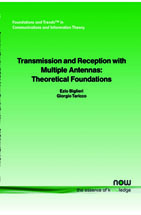Transmission and Reception with Multiple Antennas: Theoretical Foundations
By E. Biglieri, Politecnico di Torino, Italy, ezio.biglieri@polito.it | G. Taricco, Politecnico di Torino, Italy, giorgio.taricco@polito.it
Abstract
Wireless communication system design was until recently thought to have been limited in practice by time and bandwidth. The discovery that space, obtained by increasing the number of transmit and receive antennas, can also effectively generate degrees of freedom, and hence expand the range of choices made available to the design offers system designers important new opportunities. This paper focuses on the main aspects of single-user multiple-antenna theory, with the goal of presenting a comprehensive, yet compact, survey, emphasizing its mathematical aspects. After describing channel models, we compute the capacities they achieve, we briefly overview "space-time" codes, and we describe how suboptimum architectures can be employed to simplify the receiver.
Transmission and Reception with Multiple Antennas
Transmission and Reception with Multiple Antennas: Theoretical Foundations presents a comprehensive, yet compact, survey, emphasizing the mathematical aspects of single-user multiple-antenna theory. Wireless communication system design was until recently thought to have been limited in practice by time and bandwidth. The discovery that space, obtained by increasing the number of transmit and receive antennas, can also effectively generate degrees of freedom, and hence expand the range of choices made available to the design offers system designers important new opportunities.
Transmission and Reception with Multiple Antennas: Theoretical Foundations describes the channel models deployed in such systems shows how to compute the capacities achieved, overviews "space-time" codes and describes how suboptimum architectures can be employed to simplify the receiver. It provides an excellent overview for designers, students and researchers working at the forefront of wireless communication systems.
